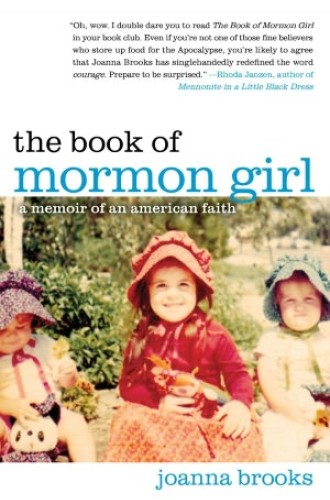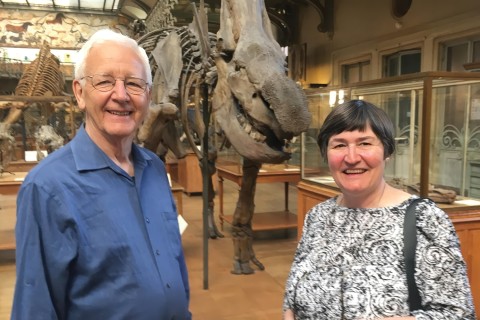The Book of Mormon Girl, by Joanna Brooks
When people who don’t know a lot about American Christianity hear that I am Mennonite, they sometimes ask if it’s the same as being Mormon. No, I say, and add a stock reply: other than starting with the same letter of the alphabet and being inscrutable to outsiders, the groups are quite different.
After reading Joanna Brooks’s memoir The Book of Mormon Girl, I will no longer answer with such alacrity. It is true that few threads connect Joseph Smith with Menno Simons or the Book of Mormon with Martyrs Mirror. But any readers of Brooks’s book who grew up in the snug orb of a conservative ethnoreligious community will come away with a sense of having traveled this way before. The comfort of churchly ritual that orders the week and of theological certitude that orders the universe, the once-persecuted minority status, the sense of tribal belonging, the gendered patterns of church and home, the ability to pick out each other in a crowd, and—oh my—the potlucks: these are the thickly textured traits of such communities that will make Brooks’s memoir feel familiar to a wide swath of readers.
Read our latest issue or browse back issues.
Just as resonant is Brooks’s journey out of religious fundamentalism and into a young adulthood full of doubts about a faith that suddenly seems prejudiced, myopic and punitive. Switch out a few doctrinal details, and you have a familiar modern account of the religious journey. That is not to say that Brooks’s autobiography is generic or predictable. Her writing is witty, poetic, at times melodramatic—and always utterly Mormon and utterly her own.
What Brooks calls her “unorthodox Mormon story” is a loving yet critical account of her childhood as the daughter of an LDS bishop in Southern California. Her young imagination was peopled with figures and events from the Book of Mormon and her own ancestral ranks, including plural wives and pioneer hardship. She tells about her father reading to her from the Book of Mormon at bedtime, making it through the entire tome before she was baptized at the age of eight. “What a gift it was,” she writes, “growing up in a world taut with conflict and luminous with meaning.”
Brooks spends much of the first half of her book detailing the filaments of culture and faith that held together her childhood universe and that connected her to other Mormons. She explains the way she could detect other Saints at gas stations or grocery stores by the size of their families, the scrubbed faces of the men, the Mormon first names and surnames, the occasional peek of a ritual undergarment, and she reminisces:
How we loved to see one another, we Mormons, out and about in the confusion of the greater world we traversed each day, undetectable, to be able to grip one another’s unstained hands with firm missionary handshakes and speak the familiar language of our people.
She idolized singer Marie Osmond, worried about accidentally choosing a Coke rather than a noncaffeinated root beer at birthday parties and grieved over the occasional attempts of born-again Christian friends to convert her. The sense of being an outlier in Orange County prompted her to attend Brigham Young University, where she could be with “people who would understand me, to whom I have to explain nothing.”
Being a student at BYU during the 1990s, however, meant seeing the progressive ferment at the edges of Mormon life get tamped down by church authorities. Having so recently breathed the oxygen of intellectual discovery, Brooks now encountered what she calls “the martial edge of Mormon orthodoxy,” as professors and others who embraced feminism and other such heresies were excommunicated. Steeped in sadness at watching the church she had loved delete her mentors from membership, Brooks subjected herself to a time of “silent excommunication”: she stayed away from Mormon ward houses and did not attend her own siblings’ weddings.
Non-Mormon friends, trying to comfort her, predicted that she would leave the church and thus find healing. But she began connecting with other disillusioned Mormons on the Internet, and when her daughters were born, Brooks felt the tug of her childhood faith even more powerfully. “How badly I want them to have a claim on the curious beauty and the power of this tradition,” she writes. “How badly I want them to make their own place in this Mormon world. My daughters emboldened me with a renewed urgency to try again.”
Trying again has not been without its hardships. Brooks confesses her continuing dissonance with other Saints and recounts her resistance to Mormon mobilization efforts for Proposition 8 in California, which would limit marriage to one man and one woman. The most expensive ballot initiative in California history was hugely funded by Mormons, who, some estimates suggest, gave at least 50 percent of the individual donations. For Brooks, taking a fussy child out of Sunday services one morning became an occasion to surreptitiously remove “Yes on 8” canvasing sheets from a bin in the narthex and stuff them under a metal grate in the parking lot.
Knowing that this and other secrets will be revealed via this book’s publication, Brooks confesses her fear that the church will begin another round of excommunications like the one in the 1990s, and that it will target progressive Mormon women like her. She has been accused of apostasy and of perverting the faith, and this book will give her detractors more fuel for their fire. But “I am not an enemy,” she writes, “and I will not be disappeared from the faith of my ancestors.”
Brooks’s memoir will be a welcome corrective for many Americans’ stereotypical views of Mormons. J. Spencer Fluhman suggests that Mormons hover “somewhere between perpetual strangeness and straitlaced blandness.” Mormon Girl joins at least four recently published scholarly treatments of Mormonism, including one by Fluhman, which seek to illuminate this most American of religions. Blogging at AskMormonGirl.com, writing op-eds and appearing frequently on news and talk shows, including a recent appearance on The Daily Show, Brooks has become a representative of the Church of Jesus Christ of Latter-day Saints—of a very different kind from Mitt Romney.
With 14 million members worldwide, the Mormon church contains not only members like Brooks and Romney—educated professionals who trace their bloodlines back to pioneers—but increasing numbers of Brazilian, Filipino and other adherents in the developing world who have none of the traditional birthright but all of the theological vigor. What they would think of Brooks’s take on the faith is a fascinating question.
Focusing more on the lived experiences of her faith than on its at times befuddling theological details, Brooks has been criticized for privileging Mormon culture at the expense of Mormon doctrine. Adam Gopnik, writing in the New Yorker, points out that in Brooks’s memoir, “Nephi, the Lamanites, the approaching apocalypse in Missouri . . . hardly come up.” Contemporary Mormonism seems to have “deliberately placed its most distinctive doctrines and icons in eclipse,” Gopnik writes. Like that of any faith tradition, the public face of Mormonism is at the mercy of its most famous adherents. It becomes a gospel of success in the hands of Mitt Romney and a gospel of inclusive social causes in the hands of Brooks.
The conundrum facing Brooks—and all of us who want to have the comforting faith of our ancestors and critique it too—is whether the ancient hymns can be passed on without the inflexible doctrinal substance. Whether any particular faith can be as capacious as its dissident members desire it to be is one of the great controversies of 21st-century religion. Believers like Brooks hope that their faith can approximate a lively potluck “as welcoming as a Pioneer Day dinner table set with a thousand cream-of-chicken-soup casseroles and wedding-present Crock-Pots”—a faith inclusive of gays and lesbians, women and men, all ethnicities, “Mormon, Jew, or gentile.” It’s a pleasant vision—and one that a Mormon woman married to a Jewish man would certainly wish to maintain. As the eschatological hope of a person of any liberal faith, it works very well.
The jury is still out, however, on how such universalist trimmings might alter the fabric of the faith to which they are attached. The irony is that the faith of Brooks’s childhood, marked by a sense of difference from the “mocking and fashionable faceless crowds,” traveled along two vectors of exclusion: the sense of having been excluded as a people, and the act of excluding previous creeds and dispensations. When a faith tradition is forged by both the experience and the enactment of rejection, can it become theologically magnanimous without becoming something else entirely? Can a religion so marked by the cleaving of the saints from the gentiles become the host of a heterodox potluck without becoming bipolar in the process? And can churches hewn from their founders’ belief in propositional truth retain the children of parents who love the myth and the metaphor but are discomfited by literal claims about fish swallowing men and men finding gold plates?
Brooks, like some of us who are from traditions occasionally confused with hers, hopes so. She chooses a road less traveled: neither settling uncritically into the pews of her ancestors’ faith nor getting the hell out of Dodge (or Deseret). Brooks’s prose will make many readers want to try a similar move within their own contexts. Indeed, her memoir may encourage readers to lay claim to the peculiar promises of their own faiths. Holding up the example of professors at BYU, who taught her the beauty of her tradition even as they were perceived as traitors to it, Brooks holds out hope for what she calls “the great unmapped possibilities of Mormonism: a life of searching inquiry, fearless because we knew all truths pointed finally to the glory of God.”





